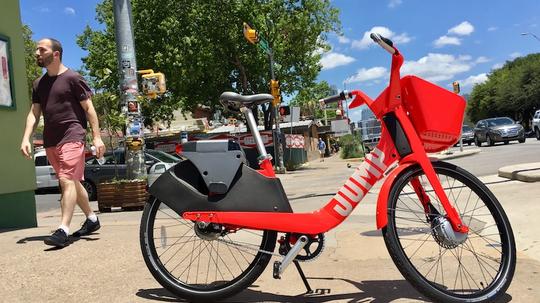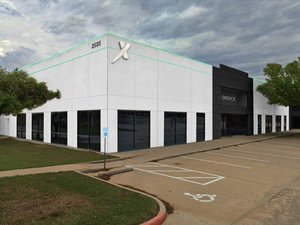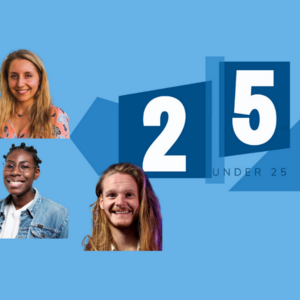
I've ridden mountain bikes, road bikes, motorcycles, e-scooters and mopeds. But never a pedal-assisted electric bicycle. So I was stoked to try out one of the JUMP e-assist bikes that are being deployed on Austin streets Monday morning.
The bright reddish bikes at first look and feel a little bulky, at least compared to an average bicycle. But that quickly becomes a non-issue because with each pedal, the bike responds by giving you a boost. After a couple pedals, it basically feels like you're going downhill.
On a cruise from near the Austin Convention Center to Joe's Coffee up the hill on South Congress, I didn't even break a sweat at noon when it was about 95 degrees out. It was pretty easy to hit 20 MPH, which is when the assist no longer helps you.
Aside from the assisted peddling, JUMP stands out because it was acquired by Uber in April and has since been integrated into the Uber app. That matters in Austin and other cities where there are five or more dockless bike and scooter apps available. You essentially need all of them to take advantage of the nearest ride.
JUMP also has an edge over many of its competitors in Austin because their bikes are already designed to comply with "lock-to" laws that require that dockless bikes and scooters be able to lock to a bike rack. Austin's lock-to law will go into effect in August, and it remains unclear what scooter companies like Bird and Lime will do to comply.
Currently, JUMP has its bikes out in San Francisco, Sacramento, Santa Cruz, Washington D.C. and it is launching in Chicago on Monday, as well. The bikes cost $2 for a 30-minute ride, and can be accessed through the Uber app or the Jump mobile app. If you go over 30 minutes, they charge $0.07 per minute.
I sat down with Trevor Theunissen, Uber Public Affairs Lead for Texas, and Dave Nelson, launch general manager with JUMP, to learn more about the bikes and where they fit in Austin's quickly evolving dockless bike and scooter ecosystem.
Theunissen says the JUMP acquisition is part of a larger vision outlined by Uber CEO Dara Khosrowshahi to build Uber into a solution for essentially any transportation need.
“The idea is that, hopefully soon, you can go into the Uber app and say 'I’m going from here to San Francisco,' and we tell you exactly what method of transportation to take, how much it would be, we plan your trip seamlessly end-to-end and you pay for it in a one-stop shop with an Uber wallet," Theunissen told me. "That’s the goal. And part of that… is getting partnership or acquisitions to get multiple modes of mobility options into the app.”
He also said that he expects JUMP to fill a gap in short-range transportation for trips that are more than a few blocks by less than, say, five or six miles. He said the average trip in San Francisco is 2.7 miles, significantly higher than industry standards for most non-assist bikes.
Nelson, who lives in San Francisco, said he expects Austin to have similarly long trips. While Austin may not be as hilly, which makes the e-assist more appealing, the city is relatively spread out and has distinct neighborhoods that are often a mile or two apart.
JUMP will initially have 250 bikes in Austin. The city has capped each dockless company at 500 devices. As part of the permitting process, JUMP and other companies will share anonymized trip data that might help the city decide where to provide more bike parking areas and bike lanes.
Even in flat areas, the bike allows you to go further and faster and have fun while you're doing it, Nelson said.
"I expect in flatter areas, we'll see longer trips," he said. "It'll be interesting to see how the average stacks up to a denser city like San Francisco."
I told Nelson and Theunissen that I could see JUMP being a great option to get to and from neighborhoods a few miles outside of downtown, which may be outside many company's service areas.
"It comes back around to that question of accessibility and density," Nelson said. "If we spread our geographical footprint out before we're able to scale our operations and make the bike supply match, then it creates an imbalance where the system isn't reliable enough."
In San Francisco, for example, the bikes are mostly positioned downtown. Around 5 p.m., the bikes fan out into neighborhoods in all directions -- so if you're leaving work late, many, if not all of them, may have been taken out of the area.
"There's a supply and demand aspect," he said. "Every city is different in that regard. That's why we're starting out with a conservative system area and with a conservative 250 bikes and making sure the demand is there and that it's needed and that people can rely on it and have a good experience."
For JUMP, this will be the first market they've launched in with so much strong competition from the likes of Ofo, Spin and others and a city-mandated data-sharing plan that will make it easy to see what's going on in the market.
"This is a really nice testing ground," he said. "It's a great opportunity for everybody to learn."








